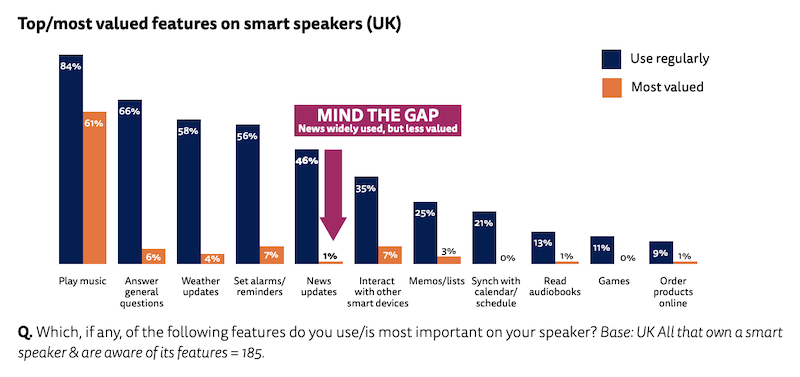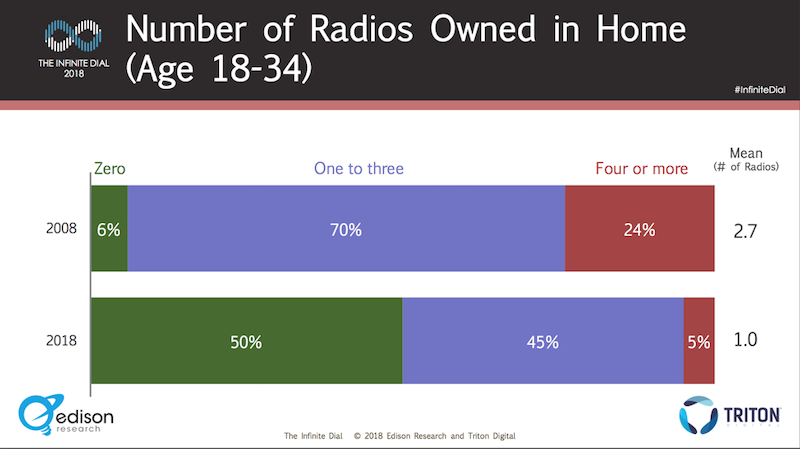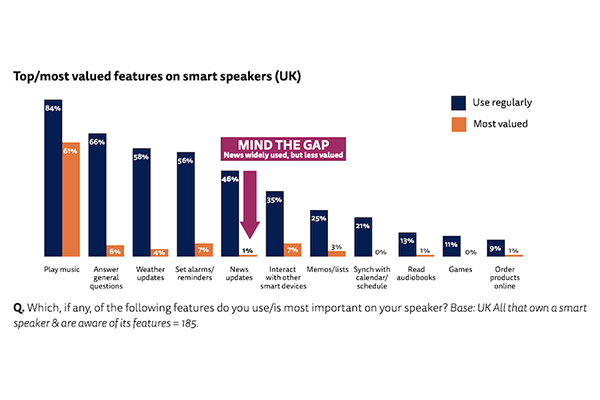Studies Confirm that Music Listening is the Killer App of Smart Speakers
Several studies have confirmed that music listening is the most popular use case for smart speakers. The Voicebot Smart Speaker Consumer Adoption Report 2018 was the first to break out music and audio content listening based not just on whether consumers had tried the features but also on how frequently these use cases stacked up against other smart speaker activities. The results were clear. Listening to streaming music was the second most tried feature, but the most used on a monthly and daily basis. In addition, listening to the radio was fourth and news/sports was seventh. The only rivals to music listening for the top spot were transactional tasks such as asking general questions and about the weather.
Music Listening Most Valued Smart Speaker Feature
A new study from the Reuters Institute for the Study of Journalism at the University of Oxford found that music listening was not only the most frequent smart speaker use case but also the most valued. In fact, when smart speaker features are prioritized by highest value, general questions and weather are more than 10-times less valued than music.

Source: The Future of Voice and the Implications for the News, September 2018, Reuters Institue for the Study of Journalism
Convenience Versus Essential Features
What we have here is the difference between mere convenience and essential features. If a smart speaker is around, consumers will ask general questions and weather status. However, these appear to be nice-to-have features that are accessed simply due to heightened convenience over accessing the information in another manner. Music listening, by contrast, appears to be the must-have feature and likely the biggest motivator for the initial purchase decision. It is also likely the biggest reason why smart speakers will have staying power in consumer homes.
The Reuters Institute study is for U.K. users and other data suggest it is reflective of U.S. consumer attitudes as well. In the U.S., the smart speaker is actually replacing the radio. Pat Higbie of XAPPmedia put this more precisely in a blog post saying “smart speakers put radios back into the home.” This is particularly true for the 18-34 age group. Data from Edison Research and NPR show that 50% of 18-34-year-olds have no radio in the home.

Radios don’t provide access to Pandora and Spotify so many Millennial consumers did not have a need for a radio in the home. Audio consumption has increasingly migrated to smartphones to accommodate changing consumer behaviors. However, smart speakers provide access to both streaming music services and radio making the latter more accessible for younger consumers outside of the car. Music listening is now transferring back to shared household devices such as smart speakers for matters of convenience and alignment with consumer tastes. Traditional broadcast radio and news consumption through smart speakers are not as high as streaming music, but the devices present an opportunity to bring both back into the home and the listening is almost entirely incremental.
On Killer Apps and Technology Staying Power
It may be hard to fathom now, but many people were puzzled for years about the tremendous growth of the internet. A large number thought it was a fad. In retrospect, the internet had at least two killer apps for consumers: email and the web. Both became fully integrated into consumers’ everyday lives. Mobile first had messaging and later social media and games to accelerate adoption. I still hear people saying that smart speakers are novelties and won’t have staying power because there is no killer app. Killer apps often become so pervasive and obvious that they are overlooked. Music listening is the killer app for smart speakers. It may not be a new concept, but it is a use case perfectly suited to the devices. Other features will be used and new features may become important over time, but smart speakers already have a foundational use case.
Voice assistants, however, are being used well beyond smart speakers. Voicebot’s Voice Assistant Consumer Adoption Report shows how different voice assistant use cases are on smartphones compared to smart speakers. When it comes to voice assistants, it may not be a single killer app, but rather a series of device-dependent killer apps. We already have our answer for smart speakers. The answer is probably there for other devices as well. We just need to recognize what is already in front of us.
You can access The Future of Voice and Implications for the News study by Nic Newman here.
Follow @bretkinsella Follow @voicebotai









